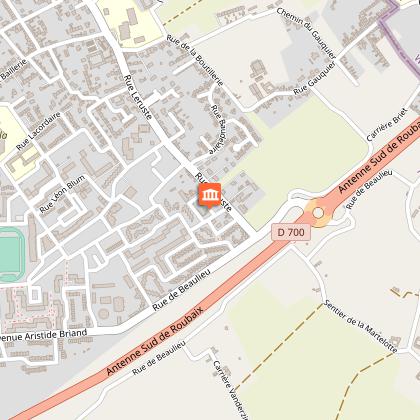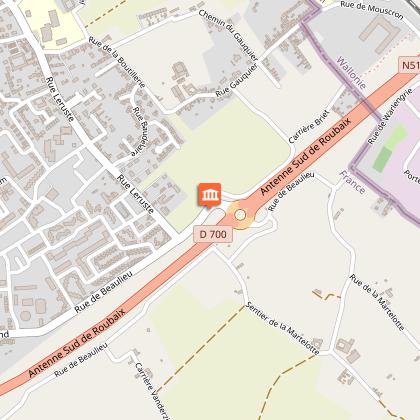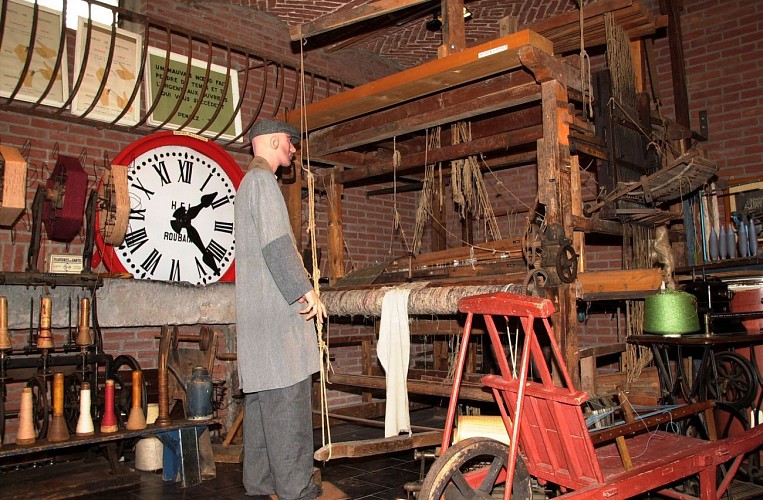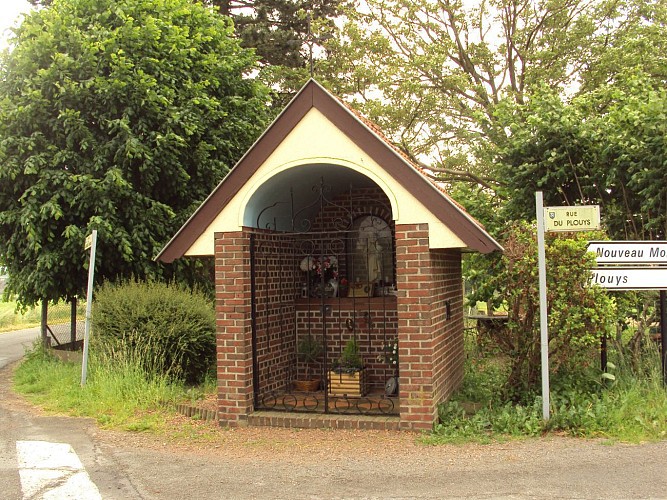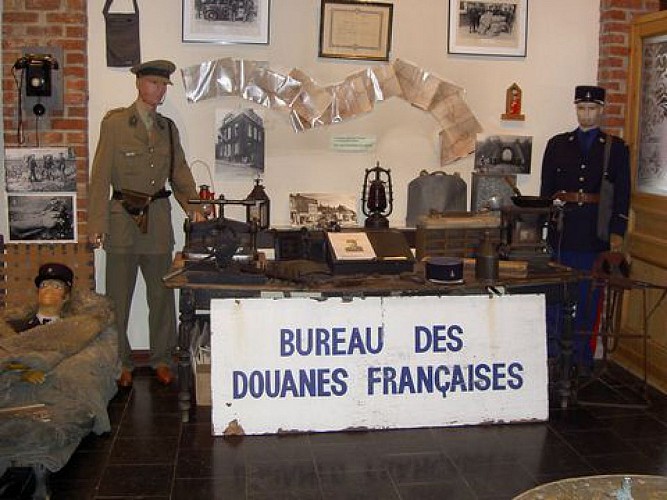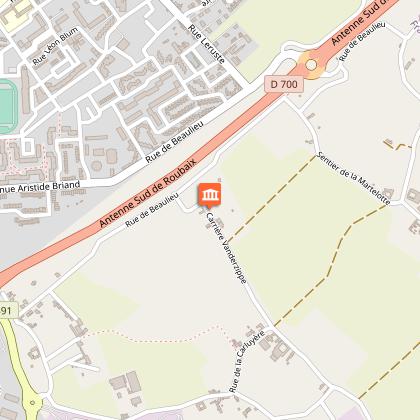Alert
Alerts
Type of practice
Walking
Easy
2h15mn
Cycling
Easy
1h30mn
Presentation
Description
Map
Points of interest
Cirkwi brief's
Ratings and reviews
See around
The Weaver's Hike

The Cirkwi brief
Discover Wattrelos: A Textile Heritage Walk
Immerse yourself in a refreshing journey through the scenic Wattrelos countryside with the "Randonnée du tisserand". This self-guided trek, crafted by Wattrelos Tourism in collaboration with Rando Evasion et Découvertes, unravels the interwoven history of the textile industry and the daily lives of home-based weavers in the late 19th century. Explore a path less traveled, revealing the essence of Wattrelos' heritage from farmsteads to workers' homes. Let this picturesque walk transport you to another era, as you step into the shoes of the weavers who once thrived in this charming locale.
Brief Technical Overview
The "Randonnée du tisserand" spans approximately 7.1 kilometers, with altitudes ranging from 18 meters at its lowest to 38 meters at its peak. The route offers a manageable positive elevation change between 26 to 28 meters, making it accessible for walkers of moderate fitness levels. Designed for pedestrian exploration, this itinerary promises a rewarding adventure through the heart of Wattrelos' textile history. A thorough understanding of these technical specifics will enhance your journey, highlighting the physical demands and the sprawling landscapes encountered along the way.
Seasonal Advice for Explorers
Embarking on the "Randonnée du tisserand"? Consider the seasonal fluctuations around Wattrelos for an optimal experience. Spring anoints the path with floral splendor, making it a picturesque time for your walk; however, rainfall is common, so waterproof gear is advised. Summer offers extended daylight for your adventure but can be warm – stay hydrated. Autumn brings a cooler ambiance and stunning foliage, though paths may be slippery with fallen leaves. Winter provides a serene, stark landscape, yet requires caution for potential ice. Regardless of the season, sturdy footwear and adequate preparation are essential for a safe, enjoyable trek.
A Glimpse into Wattrelos' Past
Wattrelos, steeped in history, played a pivotal role in the textile industry's development from the 14th century. Initially named “Waterloos” in the Middle Ages, reflecting its 'waterless' nature, this town was profoundly shaped by various epochs – from Gallo-Roman settlements to the prominence of home-based weaving in the 19th century. As a border town post the 17th century, Wattrelos witnessed significant shifts, especially with the advent of textile factories complementing agricultural practices. Understanding Wattrelos' transformation and its enduring connection to textile production enriches the journey through this evocative landscape.
Regional Climate Insights
Wattrelos, located in the Nord department of France, enjoys a temperate maritime climate characterized by mild winters and moderate summers. Rainfall is evenly distributed throughout the year, with no dry season. The best time to embark on the "Randonnée du tisserand" is between late spring and early autumn when the weather is more conducive to walking and the countryside is at its most vibrant. Planning your trek during these months will allow you to experience the region's natural beauty under the most favorable weather conditions.
Immerse yourself in a refreshing journey through the scenic Wattrelos countryside with the "Randonnée du tisserand". This self-guided trek, crafted by Wattrelos Tourism in collaboration with Rando Evasion et Découvertes, unravels the interwoven history of the textile industry and the daily lives of home-based weavers in the late 19th century. Explore a path less traveled, revealing the essence of Wattrelos' heritage from farmsteads to workers' homes. Let this picturesque walk transport you to another era, as you step into the shoes of the weavers who once thrived in this charming locale.
Brief Technical Overview
The "Randonnée du tisserand" spans approximately 7.1 kilometers, with altitudes ranging from 18 meters at its lowest to 38 meters at its peak. The route offers a manageable positive elevation change between 26 to 28 meters, making it accessible for walkers of moderate fitness levels. Designed for pedestrian exploration, this itinerary promises a rewarding adventure through the heart of Wattrelos' textile history. A thorough understanding of these technical specifics will enhance your journey, highlighting the physical demands and the sprawling landscapes encountered along the way.
Seasonal Advice for Explorers
Embarking on the "Randonnée du tisserand"? Consider the seasonal fluctuations around Wattrelos for an optimal experience. Spring anoints the path with floral splendor, making it a picturesque time for your walk; however, rainfall is common, so waterproof gear is advised. Summer offers extended daylight for your adventure but can be warm – stay hydrated. Autumn brings a cooler ambiance and stunning foliage, though paths may be slippery with fallen leaves. Winter provides a serene, stark landscape, yet requires caution for potential ice. Regardless of the season, sturdy footwear and adequate preparation are essential for a safe, enjoyable trek.
A Glimpse into Wattrelos' Past
Wattrelos, steeped in history, played a pivotal role in the textile industry's development from the 14th century. Initially named “Waterloos” in the Middle Ages, reflecting its 'waterless' nature, this town was profoundly shaped by various epochs – from Gallo-Roman settlements to the prominence of home-based weaving in the 19th century. As a border town post the 17th century, Wattrelos witnessed significant shifts, especially with the advent of textile factories complementing agricultural practices. Understanding Wattrelos' transformation and its enduring connection to textile production enriches the journey through this evocative landscape.
Regional Climate Insights
Wattrelos, located in the Nord department of France, enjoys a temperate maritime climate characterized by mild winters and moderate summers. Rainfall is evenly distributed throughout the year, with no dry season. The best time to embark on the "Randonnée du tisserand" is between late spring and early autumn when the weather is more conducive to walking and the countryside is at its most vibrant. Planning your trek during these months will allow you to experience the region's natural beauty under the most favorable weather conditions.
Automatically generated.
IGN cards
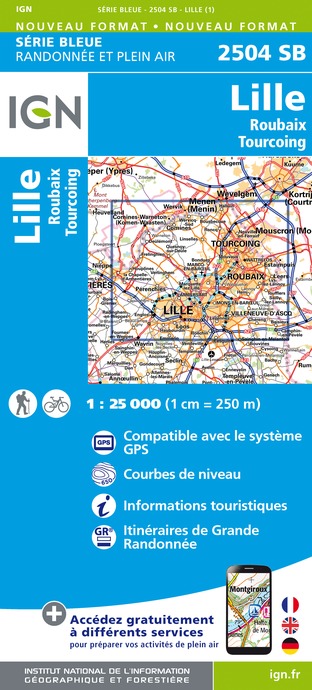
2504SB - LILLE ROUBAIX TOURCOING
Editor : IGN
Collection : TOP 25 ET SÉRIE BLEUE
Scale : 1:25 000
13.90€

102 LILLE MAUBEUGE PNR SCARPE ESCAUT PNR DE L'AVESNOIS
Editor : IGN
Collection : TOP 100
Scale : 1:100 000
8.40€

D59-62 NORD PAS-DE-CALAIS
Editor : IGN
Collection : CARTES DÉPARTEMENTALES IGN
Scale : 1:150 000
5.90€

NR01 HAUTS-DE-FRANCE
Editor : IGN
Collection : CARTES RÉGIONALES IGN
Scale : 1:250 000
6.80€

EUROPE
Editor : IGN
Collection : DÉCOUVERTE DES PAYS DU MONDE IGN
Scale : 1:2 500 000
7.00€

PAYS-BAS BELGIQUE LUXEMBOURG
Editor : IGN
Collection : DÉCOUVERTE DES PAYS DU MONDE IGN
Scale : 1:300 000
7.00€
Technical Information
Walking
Difficulty
Easy
Duration
2h15mn
(1d)
Dist.
7.1 km
Type of practice
Walking
Easy
2h15mn
Cycling
Easy
1h30mn
Show more
Altimetric profile
Starting point
49
Rue du Président Paul Doumer
,
59150
Wattrelos
Lat : 50.70431Lng : 3.2411
Points of interest
Data author

proposed by
Wattrelos Tourisme
189 rue Carnot 59150 Wattrelos France
Ratings and reviews
To see around

